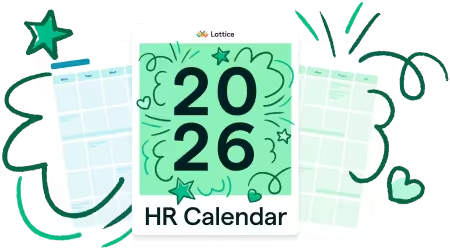Hiring Manager Guidelines Template


Download this template for free
By submitting your information, you agree to Lattice's Terms of Service and Privacy Policy. You can opt out anytime.
Thanks! We'll be in touch soon.
Hiring is one of the most important responsibilities a manager takes on. Whether you're growing your team, backfilling a critical role, or hiring for the first time, the decisions you make as a hiring manager directly shape your team’s performance, culture, and growth.
These Hiring Manager Guidelines provide a clear, step-by-step framework for leading a hiring process — from identifying a need through onboarding your new teammate. They’re designed to help you collaborate effectively with your People or Talent team, deliver a great candidate experience, and make confident, equitable decisions.
What the Hiring Manager Guidelines Should Include
To be most useful, a hiring manager guide should include:
- Role of the hiring manager: Responsibilities and expectations
- How to open a new role: Requisition, job description, approvals
- Interview process design: Who interviews, what they assess, and how decisions are made
- How to collaborate with recruiting: Ownership and communication throughout the process
- Legal and DEIB considerations: What to avoid and how to build a fair process
- Evaluating and selecting candidates: Decision-making frameworks and tools
- Making an offer: Compensation, approvals, and offer delivery
- Preparing for onboarding: What to do once the offer is signed
- Best practices for candidate experience: Timeliness, communication, and consistency
Sample Hiring Manager Guidelines
{{rich-highlight-1}}
Effective Date: [Insert Date]
Policy Owner: Talent Acquisition / People Team
Last Reviewed: [Insert Date]
1. Your Role as the Hiring Manager
As a hiring manager, you are the owner of the role. You’re responsible for:
- Defining what success looks like
- Aligning the job description with team needs
- Providing timely feedback on candidates
- Creating a fair and structured interview process
- Making the final decision (in partnership with your recruiter)
- Supporting an inclusive and positive candidate experience
- Preparing for your new hire’s onboarding and ramp-up
You’ll collaborate closely with your recruiter, who will guide you on sourcing strategy, process logistics, and market insights.
2. Opening a Role
To open a new role:
- Complete a Headcount Request Form (if applicable)
- Draft or update the job description, including title, responsibilities, required qualifications, and leveling
- Align with HR and Finance on compensation banding and budget
- Submit for approval via your company’s ATS (Applicant Tracking System) or internal approval process
Once approved, your recruiter will launch the job posting and begin sourcing.
3. Designing the Interview Process
Work with your recruiter to define:
- The number of interview stages (e.g., recruiter screen, hiring manager interview, panel interview, final presentation)
- Who will interview (including DEIB or skills-based interviewers)
- What competencies each interviewer will assess
- Which evaluation criteria will be used — ideally aligned to a structured scorecard
- Timeframe for process milestones (e.g., goal to fill the role within 45 days)
Tip: Structured interviews lead to better, more equitable hiring outcomes. Avoid ad-hoc or duplicative interviews.
4. Interview Best Practices
- Ask consistent, role-relevant questions of each candidate
- Take clear, objective notes
- Avoid illegal or inappropriate questions (e.g., age, marital status, nationality, medical history)
- Stay focused on role competencies, not “culture fit”
- Provide feedback in your ATS or directly to your recruiter within 24–48 hours
Remember: You’re not just evaluating the candidate — they’re evaluating you, too. Be responsive, prepared, and respectful of their time.
{{rich-highlight-3}}
5. Evaluating and Selecting Candidates
After each round:
- Debrief with your recruiter and interview panel
- Compare candidates using structured scorecards and notes — not gut feelings
- Avoid bias by focusing on competencies and alignment with role expectations
- If multiple candidates are strong, consider long-term team needs, growth potential, and diversity goals
You are the final decision-maker, but consult your recruiter and functional leaders to ensure calibration.
6. Making the Offer
Once you’ve selected a candidate:
- Confirm compensation package with your recruiter and/or HR
- Submit a final offer request through your ATS or internal workflow
- Your recruiter will extend the offer, manage negotiations, and send the formal offer letter
Do not promise anything (salary, sign-on bonus, start date, etc.) before HR confirms it’s approved.
7. Preparing for Onboarding
Once your offer is accepted:
- Reach out to welcome your new hire and confirm logistics
- Set up their 30-60-90 day onboarding plan
- Schedule intro meetings with key stakeholders
- Assign a mentor or onboarding buddy, if applicable
- Ensure they have equipment, system access, and workspace (if in-person)
The onboarding experience starts the moment the offer is signed. A strong first impression increases retention and engagement.
8. DEIB and Legal Considerations
As a hiring manager, you are responsible for maintaining a fair, inclusive hiring process. This means:
- Avoiding questions that touch on protected characteristics (e.g., race, religion, disability, family status)
- Being mindful of bias (e.g., affinity bias, halo/horns effect, first impression bias)
- Ensuring interview panels reflect diversity of thought and background
- Working with your People Team to understand legal compliance and documentation requirements
Tip: If in doubt, ask HR before the interview — not after.
9. Collaborating with Your Recruiter
Your recruiter is your partner throughout the process. Their responsibilities include:
- Writing and posting the job
- Sourcing and screening candidates
- Scheduling interviews and managing logistics
- Providing compensation benchmarks
- Managing the offer and closing process
- Acting as a candidate advocate and communicator
Maintain open communication. Weekly check-ins are ideal for high-priority roles.
Frequently Asked Questions
1. How long should the interview process take?
Aim to complete interviews and make a decision within 3–4 weeks of posting the job. Your recruiter will help track and adjust timelines.
2. Can I adjust the job description mid-search?
Yes, but it’s best to finalize key responsibilities and qualifications before posting. Major changes should be reviewed by your recruiter and HR.
3. Can I reach out to candidates directly?
It’s best to communicate through your recruiter for consistency and compliance — especially during the offer process.
4. What if I want to reject a candidate I previously liked?
That’s okay — priorities shift. Just document your rationale clearly and respectfully, and let your recruiter manage the communication.
5. How can I help create a more inclusive hiring process?
Use structured interviews, diverse panels, and consistent evaluation criteria. Ask HR for DEIB interview training or inclusive job description templates.
🚩 Please note: This sample is for informational purposes only and should be adapted based on your internal hiring processes, tools, and legal requirements.
✨ Disclaimer: This resource was developed with the help of artificial intelligence, though reviewed, edited, and approved by (real) humans.
Frequently Asked Questions

Your people are your business
Ensure both are successful with Lattice.





.webp)